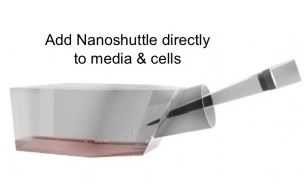
生物装配器,三维细胞培养技术
产品名称: 生物装配器,三维细胞培养技术
英文名称: bioassembler 3d cell culture environment
产品编号: bioassembler
产品价格: 0
产品产地: 美国
品牌商标: N3D
更新时间: null
使用范围: null
- 联系人 :
- 地址 : 中国上海上海上海市
- 邮编 : 201112
- 所在区域 : 上海
- 电话 : 180****9478
- 传真 :
- 邮箱 : brightzhou@micoforce.com
Nature Nanotechnology 5, 291 - 296 (2010) Published online: 14 March 2010 | doi:10.1038/nnano.2010.23 Subject terms: Nanomaterials | Nanomedicine Three-dimensional tissue culture based on magnetic cell levitation Glauco R. Souza1,9, Jennifer R. Molina2, Robert M. Raphael3, Michael G. Ozawa1, Daniel J. Stark4, Carly S. Levin5, Lawrence F. Bronk1, Jeyarama S. Ananta6, Jami Mandelin1, Maria-Magdalena Georgescu2, James A. Bankson7, Juri G. Gelovani8, T. C. Killian4, Wadih Arap1 & Renata Pasqualini1 Abstract Cell culture is an essential tool in drug discovery, tissue engineering and stem cell research. Conventional tissue culture produces two-dimensional cell growth with gene expression, signalling and morphology that can be different from those foundin vivo, and this compromises its clinical relevance1, 2, 3, 4, 5. Here, we report a three-dimensional tissue culture based on magnetic levitation of cells in the presence of a hydrogel consisting of gold, magnetic iron oxide nanoparticles and filamentous bacteriophage. By spatially controlling the magnetic field, the geometry of the cell mass can be manipulated, and multicellular clustering of different cell types in co-culture can be achieved. Magnetically levitated human glioblastoma cells showed similar protein expression profiles to those observed in human tumour xenografts. Taken together, these results indicate that levitated three-dimensional culture with magnetized phage-based hydrogels more closely recapitulates in vivo protein expression and may be more feasible for long-term multicellular studies. 3D三维细胞磁悬浮培养仪用于三维组织培养,在药物开发、组织工程和干细胞的研究 三维细胞培养的新进展[创新技巧] 【字体: 大 中 小 】 www.ebiotrade.com 时间:2010年04月01日 来源:生物通 摘要: 传统的二维细胞培养并不是细胞生长的天然状态,因而细胞的基因表达、信号转导和形态学都可能与天然有异。最近,美国莱斯大学和德克萨斯大学M.D. Anderson癌症中心的研究人员阐明了一种更为简单的三维培养技术,文章发表在3月14日的《Nature Nanotechnology》上 传统的二维细胞培养并不是细胞生长的天然状态,因而细胞的基因表达、信号转导和形态学都可能与天然有异。为了避免这些影响,研究人员一直在利用蛋白凝胶和生物反应器来开发三维的细胞培养基技术。最近,美国莱斯大学和德克萨斯大学M.D. Anderson癌症中心的研究人员阐明了一种更为简单的三维培养技术,文章发表在3月14日的《Nature Nanotechnology》上。 研究小组开发出一种生物装配器(bioassembler)。这个系统使用磁力让细胞悬浮,并促使细胞生长成三维的形状。悬浮过程是基于一种生物无机的水凝胶(hydrogel),这种水凝胶由三部分组成:噬菌体、磁性氧化铁和金纳米颗粒。研究小组使用的噬菌体是M13来源的,展示了RGD-4C配体肽段,以靶定金纳米颗粒和磁性氧化铁。这种基于磁性环的技术与所有标准的培养技术兼容,因此可推广到大部分实验室。 为了构建培养系统,研究人员在包含细胞的水凝胶中加入了纳米颗粒和噬菌体。由于噬菌体上表达了配体肽段,它就能靶定纳米颗粒。当噬菌体感染细胞,也就将纳米颗粒运输到细胞内。研究人员随后洗掉凝胶,在充满基质的Petri dish中接种含有纳米颗粒的细胞。一旦细胞装有纳米颗粒,它们就会对磁力有反应,研究人员在Petri dish的顶部安装磁力环。 为了评估这种技术下的细胞生长,研究人员在8天的时间内肉眼观察并定量监测了人胶质母细胞瘤细胞的形成率、大小和存活率。他们利用红色荧光蛋白来监测细胞。 24小时后,多细胞聚集物开始悬浮在液体中。在接下来的72小时到192小时,椭球体的最大直径达1mm。在检测了胶质母细胞瘤体外产生的蛋白后,研究人员发现三维培养表达了适当的蛋白,而对应的二维培养没有。他们认为,三维培养适合这些肿瘤的研究。而二维培养中蛋白的缺乏,表明它不是研究癌症的有效方法。 莱斯大学生物工程系的副教授Robert Raphael认为:“这种方法的美就在于它利用天然的细胞间相互作用来驱动三维结构的形成。此方法相当简单,任何对药物开发、干细胞或再生医学感兴趣的实验室都可以此作为三维细胞培养的起点。“ 这种三维组织培养有望应用在疾病研究上。M.D. Anderson癌症中心的Wadih Arap教授表示:“对于癌症研究,磁场所产生的‘隐性支架’已经不再是单纯的细胞培养,而让它们更像真正的肿瘤。我们下一步将应用这种磁性来探索肿瘤成像和治疗上的应用
